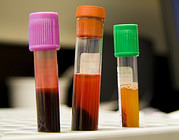Elevated
Inflammatory Biomarkers Are Associated with Progression to AIDS and Death
despite Viral Suppression
 |
 |
 |
 |
 |
 |
 |
| SUMMARY:
Individuals with elevated baseline levels of the inflammatory
biomarker CRP and the fibrosis biomarker hyaluronic acid were
more likely to progress to AIDS, develop immune reconstitution
inflammatory syndrome (IRIS), or die within the first month
after starting antiretroviral
therapy (ART), according to a poster presented at the
17th Conference on Retroviruses and Opportunistic Infections
(CROI 2010) last month in San Francisco. |
|
 |
 |
 |
 |
 |
 |
 |
By
Liz Highleyman
A growing body of evidence indicates that systemic inflammation and
immune activation are associated with an increased risk of progression
to AIDS, non-AIDS conditions such as cardiovascular disease, and death
in people with HIV.
 Investigators
with the INSIGHT collaboration performed a case-control study to assess
the relationship between 3 blood biomarkers -- C-reactive protein (CRP),
pro-inflammatory cytokines, D-dimer, and hyaluronic acid -- and risk
of AIDS or death occurring during the first year after ART initiation.
Investigators
with the INSIGHT collaboration performed a case-control study to assess
the relationship between 3 blood biomarkers -- C-reactive protein (CRP),
pro-inflammatory cytokines, D-dimer, and hyaluronic acid -- and risk
of AIDS or death occurring during the first year after ART initiation.
Significant illness and mortality can occur during the first year of
ART despite good viral suppression, the researchers noted as background.
This may be due to IRIS (worsening of symptoms as the recovering immune
system begins to react to existing pathogens), new infections, drug-related
toxicities, or non-AIDS related events. Biomarkers, they suggested,
might help identify high-risk people who require closer monitoring after
starting treatment.
This analysis included 189 participants in the FIRST trial, which compared
3 types of first-line ART regimens in people with advanced HIV/AIDS.
Out of more than 100 participants who experienced at least a 10-fold
drop in HIV RNA during the first month on therapy, the investigators
identified 63 patients who experienced AIDS, IRIS, or death within the
first year on ART, and selected 126 control patients who did not experience
disease progression, matched for demographic characteristics, CD4 cell
count, and hepatitis B and C
coinfection status if possible.
The researchers compared blood levels of about 20 biomarkers at baseline
and after the first month on ART. These included CRP, pro-inflammatory
cytokines including tumor necrosis factors (TNF-alpha) and interferon-gamma,
interleukin 6 (IL-6, a pro-inflammatory cytokine), IL-8, IL-10 (an anti-inflammatory
cytokine), chemokines, the coagulation marker D-dimer, sCD14, intestinal
fatty acid binding peptide (IFABP), and hyaluronic acid. Hyaluronic
acid is an extracellular matrix component used as a biomarker for liver
fibrosis, but it may also signal tissue damage and repair elsewhere
in the body.
Results
 |
Participants
in the case group were significantly more likely than those in the
control group to have had an AIDS-defining condition before starting
ART (73% vs 51%). |
 |
During
the month of follow-up, the following endpoints occurred: |
| |
 |
46
patients progressed to AIDS; |
 |
28
patients developed IRIS; |
 |
22
patients died. |
|
 |
Looking at all endpoints combined, case patients had higher baseline
levels of CRP, IL-6, IL-10, D-dimer, and hyaluronic acid. |
 |
Patients
who developed IRIS had higher baseline levels of TNF-alpha, IL-10,
and D-dimer. |
 |
After
1 month, case patients still had higher levels of several biomarkers
including CRP, TNF-alpha, interferon-gamma, IL-6, IL-8, and D-dimer,
than control patients. |
 |
In
a multivariate analysis controlling for confounding factors including
pre-treatment levels of CRP, IL-6, IL-10, and hyaluronic acid, only
CRP and hyaluronic acid remained independent risk factors for AIDS
or death. |
 |
Dividing
biomarkers levels into quartiles, patients with the highest levels
of both CRP and hyaluronic acid relative to those with the lowest
levels had: |
| |
 |
More
than twice the risk for AIDS or death (odds ratio [OR] 2.6); |
 |
5
times the risk of IRIS (OR 5.1). |
|
 |
However,
high CRP plus low hyaluronic acid, or vice versa, were not associated
with increased risk of any endpoints. |
Based
on these finings, the investigators concluded, "Elevated levels
of biomarkers associated with inflammation (CRP, IL-6), coagulation
(D-dimer) and tissue fibrosis (hyaluronic acid) in ART-naive patients
who have good virologic response may be useful in identifying patients
at risk for AIDS or death during the first year of ART."
A
related study found associations between elevated hyaluronic acid
plus inflammation biomarkers and increased risk of death due to non-AIDS
causes in HIV/HBV and HIV/HCV coinfected people.
University
of Minnesota, Minneapolis, MN; NIAID, NIH, Bethesda, MD; SAIC-Frederick,
MD; University of Western Australia, Perth, Australia; University of
Illinois, Chicago, IL.
3/12/10
References
D
Boulware, K Huppler Hullsiek, C Puronen, and others (INSIGHT Group).
Higher Levels of D-dimer, C-reactive Protein, Hyaluronic Acid, and IL-6
before Initiation of ART Are Associated with AIDS, IRIS, or Death among
ART-naive Patients with a Good Virologic Response to Initial ART. 17th
Conference on Retroviruses & Opportunistic Infections (CROI 2010).
San Francisco. February 16-19, 2010. (Abstract
335).